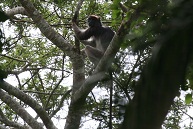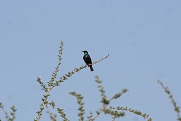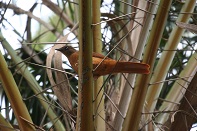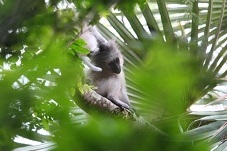Photos with this report (click to enlarge) | |||
 Tana River Red Colobus |
 Violet-breasted Sunbird |
 Fasciated Snake-Eagle |
|
 Red-tailed Ant-Thrush |
 Tana River Mangabey |
||
I’d visited the Sokoke Forest a couple of times with Albert of Spinetail Safaris (spinetailsafaris@yahoo.com, www.spinetailsafaris.com). During one of the trips, he mentioned that he could arrange a visit to the Tana River Primate Reserve, but suggested I wait until November when the weather was likely to be best. It turned out to be an amazing trip, but a very long drive for just two days. Because of the high 4WD prices, we used a minivan. It’s a reasonably good, tarmac road over 100km north from Malindi to the town of Garsen near the Tana River delta—a well frequented road that continues to the popular coastal resort of Lamu.
From Garsen, we turned inland and travelled through desert scrub about 40km on a road that seemed promisingly good for the first 5km or so but eventually became atrocious. They’d had heavy rain the weeks before, and the main road was rutted beyond use – the traffic had established two separate side roads, also horribly rutted, but you could make your way using a combination of both.
Security is also an issue in this area. There are reports of robberies on the Garsen-Garissa road (of which this is the first stretch) and understand there is advice not to travel it at night—some embassies advise not to visit this area at all. If you go, best to travel with someone like Albert who has been there before.
There’s quite a lot of wildlife along the road north from Garsen –many dik-dik, Eastern Chanting-Goshawk, a couple of Lesser Kudu and several large coveys of Vulturine Guineafowl. Driving through the desert, it’s hard to believe there is forest anywhere nearby. Even the Primate Reserve ranger station is in the same habitat—we introduced ourselves (Albert had contacted the head ranger in advance, who congratulated us on navigating the “best road in Africa”), then a ranger joined us for the drive to the campsite.
After another few kilometers through the scrub, there’s an amazing, sudden transition to tropical rainforest—I was expecting a thin strip of gallery forest, but it’s real rainforest, about half a kilometer each side of the river—the soil completely changes, and there are tall rainforest trees with buttress roots and thick undergrowth. The campsite is right in the forest and they have a couple of beautifully situated tented camps with beds, sheets and blankets, flush toilets and cold showers. The cold shower is not a problem, since the air is so hot and muggy in the forest here and there’s no sea breeze this far inland.
Food availability is limited. One of the rangers managed to rustle up a chicken stew and some tea in the evening, we mostly lived off the bread and bananas Albert had brought from Malindi.
There are two main habitats in this area—the rainforest, and the Commiphora brush. The rainforest denizens include the two unique monkeys—Tana River Red Colobus (actually grey with a red cap) and Tana River Mangabey (mostly whitish, with a black face). Both are quite common and we saw them several times in the day we spent there. Many of the coastal forest birds are present. We had good views of a Fasciated Snake-Eagle soaring then perched, Red-tailed Ant-Thrush, Red-capped Robin-Chat and Bearded Scrub-Robin are common and the Ant-Thrush exceptionally tame, Mombasa and Green-backed Woodpeckers, many Eastern Olive-Sunbirds and Trumpeter Hornbill, a shy group of Terrestrial Greenbul, Fischer’s Turaco and Narina Trogon heard, and a Crested Guineafowl preparing to roost on a branch just before dusk, next to a tiny young Skyes’s Monkey (the third and probably the commonest type of monkey in the forest here—Vervet Monkey and Baboon are present in the nearby scrub).
You can walk just a few metres from the forest camp to the river itself—sitting by its banks (if you don’t mind the mud), it feels like you are next to any other rainforest river, complete with crocodiles and hippo. There was a boat propped up against one of the buttress roots by the river, so maybe boat rides are a possibility if you’re interested.
Outside the forest is Commiphora brush, where we enjoyed a sweat-fest for a few hours in the afternoon. It looks like the desert scrub we had driven through from Garsen – but whereas that consisted of widely spaced, stunted acacias, the Commiphora has many areas that are more an unbroken tangle of thornbush. It’s perhaps even more interesting than the forest for birds, judging by which it still must also count as a “riparian” habitat. Black-bellied Sunbird was one of the commonest birds—many males singing from the treetops. We also saw Collared, Variable and Violet-breasted Sunbird, the latter a localized bird inhabiting rather insecure areas from the Tana River area up to the Somali coast south of Mogadishu. Magpie Starling and Black-bellied Glossy-Starling are common. Albert persistently tracked down a very shy group of Scaly Babbler after hearing the birds call, and also found some fresh lion footprints.
Heading up to Tana is a trek, and again it’s good to check the security situation before making the trip, but visiting this remote patch of rainforest surrounded by miles of desert was a real adventure.
Albert says he has visited an even larger forest (complete with Sokoke Scops) even further north, on the border with Somalia, so there is a lot more exploring to be done if the security situation ever improves.